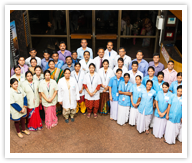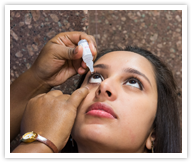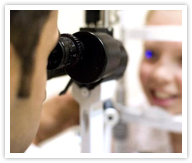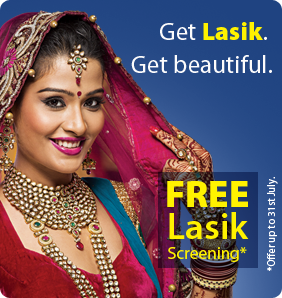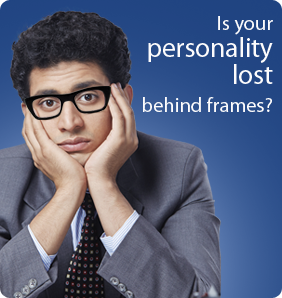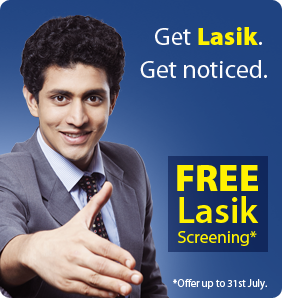Lasik
LASIK (Laser Assisted In-situ Keratomileusis) is commonly referred to simply as laser eye surgery. It is a procedure performed by ophthalmologists by using a laser beam to correct refractive errors. In this procedure the cornea is reshaped to treat short-sightedness, long-sightedness and astigmatism and restore normal vision. Most people therefore do not need spectacles or contact lenses after LASIK treatment unless the initial refractive error is very high.
Refractive Errors
Short sightedness - Myopic Eye (Minus Power) is longer than normal or has a steep cornea as a result the light rays focus in front of the Myopic Eye (Minus Power) retina. Close objects look clear, but distant objects appeared blurred.
Far sightedness - Hyperopic Eye (Plus Power) is a refractive error which means that the eye does not bend or refract light rays properly to a entering eye single focus to see images clearly. In Hyperopia, distant objects look somewhat clear but close objects appear blurred.
Astigmatism (Cylindrical Power) when the cornea has an irregular shape, it is called corneal astigmatism. When the shape of the lens is distorted, you have lenticular astigmatism. In both the cases, your vision for near and far objects appears blurred or distorted. It's almost like looking into a fun-house mirror in which you appear too tall, too wide, or too thin.
Eligibility
In order to get the full benefit of LASIK treatment, you must be
- At least 18 years of age or older but preferably below 40
- Have healthy eyes free from retinal problems, corneal scar or any other eye disease.
- Have a refractive error within the range of -1 to -7 diopters.
- Have less than 3 diopters of Astigmatism.
- Patients who have "higher order" aberrations may also be recommended by Custom LASIK as part of a treatment plan.
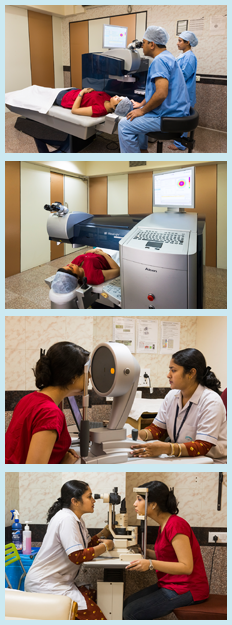
The Procedure
The entire procedure is performed as out-patient using topical (local) anesthesia drops which will numb your eyes only. You will be awake during the entire procedure.
You will lie face up under the laser machine. The surgeon will enter your refractive correction to the laser's computer and will ask you to familiarize yourself with green and red fixation lights inside the laser delivery tubes. One or two sessions may be performed to help you to get comfortable to the sound and the sensation.
Once you are comfortable the surgeon will proceed for the creation of corneal flap by using Micro Keratome. A sensation of pressure of the eye will be felt usually without pain. It is important for you to help your surgeon during this procedure by avoiding excessive eye movements. Once the initial step is over, the surgeon activates the laser to perform the cornea sculpting. The usual laser delivery times ranges from 15 -45 seconds.
At the conclusion of the procedure, the patient will be provided with dark glasses as no hospitalization is required.
The Technology
PBA Eye uses a Wavelight Excimer Laser 500 Hz Eye Surgery Technology for high frequency LASIK procedures. The German technology enables application of tiny laser pulses to the cornea with utmost accuracy to emphasize quality safety and precision of the results.
A high speed eye tracker follows the eyes fastest movements checking the eyes positions 500 times per second ensuring an accurate placement of each laser pulse on the cornea resulting in the safest & most effective corrective procedure available in today's world.
The Excimer laser is a cool laser and does not generate heat in the cornea and the number of spots and pattern of application are delivered under computer control so that the curvature of the cornea is accurately altered to achieve the desired correction. By specifically removing tissues from different positions of the cornea, the surgeon is able to correct the different refractive errors.
FAQs
How long does LASIK surgery procedure take?
After the preparation where eye drops are instilled into your eyes the entire procedure takes about 5 - 7 minutes per eye.
Will my vision improve immediately after the procedure?
You should be able to see reasonably well within a few days after your procedure. Your vision may fluctuate for a period of 1 - 2 months and the same is likely to stabilize around a month after the procedure.
Can both eyes be treated at the same time?
It can be performed at the same time but the timing for the treatment of 2nd eye is at the discretion of your surgeon.
When can I resume my normal activities?
If you have had LASIK, you will return to work on the following day.
How many times do I need to be seen following the LASIK procedure?
Most patients are usually seen the next day after the procedure and then after a month and again after three months. Remember, we are available 24 hours for any questions or concerns. The Hospital also has 24 hour emergency facility.
What is custom LASIK (C-LASIK)?
Custom LASIK Eye procedure provides a more precise treatment for patients who have "higher order" aberrations, which is measured with the Aberrometer. For these patients, customized laser eye surgery may provide a better quality of vision by measuring and addressing all of these aberrations as part of treatment plan.
Benefits
10 great reasons to have LASIK eye surgery
LASIK eye surgery is becoming more and more common with advances in technology, causing many people to ask themselves if LASIK is right for them. If you have never heard of LASIK laser vision correction, it is a permanent surgery that reshapes your cornea and corrects your vision. The surgery shapes your eye to correct the incoming light the same the way your glasses or contacts were before. Here are the top ten reasons you should get LASIK eye surgery:
- LASIK pays for itself because you no longer have to pay for glasses or contact lenses. Add up how much you have spend over the last few years buying new prescriptions and the cost will be much higher than what you will pay for LASIK.
- You can wake up in the morning and actually see the world clearly! Many people have LASIK surgery done for this reason alone. How nice would it be to be able to wake up and not have to search for your glasses, or stumble around to put in your contacts?
- No more coordinating your wardrobe. For the fashion conscious amongst us, this is a huge benefit. Not having to figure out what goes best with your glasses is great. You can wear whatever you want whenever you want.
- For athletic people, LASIK is a fantastic option. Many sports are difficult or impossible to play while wearing contacts or glasses. How many times have you jumped into a swimming pool and lost a contact? You will never have that problem again with LASIK. You can swim as much as you want without any concern of losing a contact or spending money on prescription goggles.
- Visual freedom. Just imagine never having to think about your vision ever again. This is what LASIK will do for you. All you have to do is open your eyes to see. Never again deal with eye drops because your contacts dried out.
- Freedom while traveling. No more worrying about bringing along the back up set of contacts or glasses. No more solutions or cases. Being able to see the world with no strings attached is worth it in itself.
- You can finally be comfortable. Contacts often cause allergic reactions, itchiness, red eyes, burning and other irritations. Glasses can be even worse, causing painful headaches due to pressure or being slightly off prescription. With LASIK you will never have these problems again.
- Better vision then before. Many patients experience clearer sight after LASIK than they did with corrective eye wear.
- Instant gratification. No long recovery period. After you come home from your surgery you will be able to see the world around you in all its glory within hours.
- A whole new you. Many of us feel uncomfortable in glasses, but you will never again have to feel self-conscious about yourself, so go out and have some fun!





